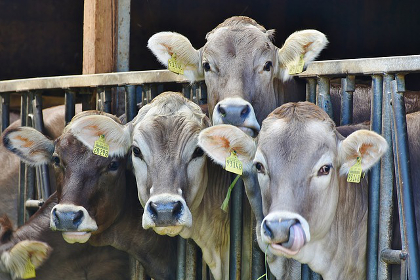
The Dirty Underbelly of the Dairy Industry
Contrary to popular belief, pasteurized CAFO milk is NOT safer than raw milk from a healthy, grass-fed cow raised according to organic standards. Data shows that illnesses linked to raw milk are minimal, and far lower than those from pasteurized CAFO milk.
September 6, 2016 | Source: Mercola.com | by Dr. Joseph Mercola
I've written extensively about the differences between raw grass-fed milk and dairy from cows raised in concentrated animal feeding operations (CAFOs), explaining the many health and environmental benefits of the former and the risks associated with the latter.
Contrary to popular belief, pasteurized CAFO milk is NOT safer than raw milk from a healthy, grass-fed cow raised according to organic standards. Data shows that illnesses linked to raw milk are minimal, and far lower than those from pasteurized CAFO milk.
The reason for this has to do with the abnormal diet fed to CAFO cows. Grass is a cow's natural food. Corn (nearly always GMO) and other grains, which are routinely fed to CAFO livestock, are not.
When cows eat grains, their body composition is altered and so is their milk, resulting in an inferior nutritional profile. Pasteurization also destroys many valuable nutrients — many of which have notable benefits for your digestion and immune function.1
Interestingly, cows, like humans, fed a high-grain diet will die prematurely. Many times a grain-fed cow's life expectancy will be decreased by more than 50 percent. This is not typically an issue however, as the animals are sacrificed long before that time.
Pasteurized CAFO Dairy Far More Likely to Cause Disease Than Raw Milk
The U.S. Centers for Disease Control and Prevention (CDC) frequently cites raw milk as a leading cause of foodborne illness outbreaks and deaths. However, if you look at the actual data, you will not find ANY deaths linked to raw milk in the U.S.
You can get the whole story in my previous article, "How the CDC Transformed 21 Raw Milk Illnesses Into 20,000." In the U.K., not a single case of illness from drinking raw milk has been reported since 2002.2
Meanwhile, just last year, ice cream from Blue Bell Creamery — the third-largest ice cream maker in the U.S. — sickened 10 people with listeria; three died as a result. The price for causing three deaths? A mere $175,000 fine.3
Raw dairy farmers have been put out of business for mere suspicion of contamination. Even in the absence of a complaint of contamination, farmers and consumers are often harassed over the buying and selling of raw milk.
Such is the case in Harris County, Texas, where the Farm and Ranch Freedom Alliance and raw milk consumers claim they're being threatened by public health officials even though they're not doing anything illegal. As reported by YourHoustonNews.com:4
"Raids have taken place at raw milk drop points to stop consumers from picking up raw milk. The raw milk consumers and producers are in fear of being shut down or fined by authorities.
'Generally, when the health department has a concern about a business, they will talk to that business and they will go through the concerns.
What's been happening is that they have been showing up in Katy with the sheriff's deputies and in Austin they showed up with the police,' said Judith McGeary, executive director of Farm and Ranch Freedom Alliance. 'This isn't how food inspections are handled typically. It is very out of line.'"
Clearly, the attack on raw milk is aimed at controlling the dairy industry, NOT to save you from yourself, should you be convinced that raw milk is a healthy food and choose to go out of your way to obtain and drink it!
Ongoing Listeria Contamination Found at Jeni's Splendid Ice Cream
In 2013, Chobani Greek yogurt was recalled following reports of gastrointestinal illness.5 The yogurt, which is pasteurized and not raw, was found to be contaminated with a fungus called Murcor circinelloides.
Listeria bacteria was also recently found in Jeni's Splendid Ice Creams' Columbus, Ohio, facility, prompting the U.S. Food and Drug Administration (FDA) to issue a warning letter to the company.
The same strain of listeria was found in samples collected in April 2015, suggesting the company is struggling with an ongoing contamination problem.6
As a rule, CAFOs are hotbeds for disease-causing bacteria that can easily end up in the final product, be it milk, cheese, yogurt or ice cream. Pasteurization is thought to kill off all of these bacteria, but reality tells a different story. Part of the problem is the sheer volume of food being processed.
All you need is for one portion of the processing plant to be contaminated in order for massive amounts of food to be contaminated — and it doesn't matter if it's been pasteurized or not. In the case of Jeni's Splendid Ice Cream, the source of the 2015 contamination was traced to a contaminated spout on one of its machines.
CAFOs also promote antibiotic-resistant disease that kills an estimated 23,000 Americans each year, courtesy of the routine use of antibiotics to keep livestock healthy enough while crammed together in unsanitary conditions.
But there's yet another major difference between organic grass-fed dairy farming and CAFOs, and it has to do with the amount of pesticides used on cattle feed. Not only does it contribute to environmental devastation, but the end product may also contain herbicide residues that could affect your health.
